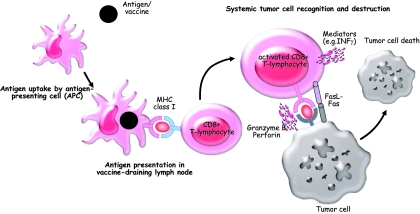Figure 1.
Proposed mechanism of action for cancer vaccines. Tumor antigens (e.g., administered as proteins, peptides, or whole tumor cells) are taken up and processed by specialized antigen-presenting cells (APCs) such as dendritic cells (DCs). DCs migrate to the vaccine-draining lymph nodes and present relevant antigens to CD8+ T lymphocytes, which, in turn, are able to recognize tumor cells throughout the body and destroy them by several effector mechanisms such as the perforin/granzyme pathway, direct cell–cell interaction (e.g., Fas/Fas ligand), or certain mediators (e.g., INFγ). Not shown but also of importance are B lymphocytes, CD4+ T helper cells and cells of the innate immune system such as natural killer cells and macrophages.
Abbreviations: INF, interferon; MHC, major histocompatibility complex.

